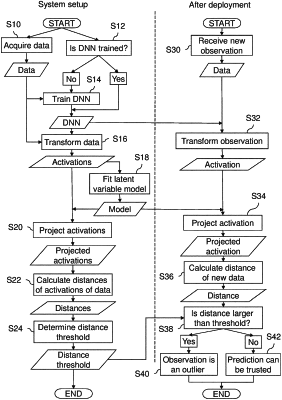| CPC G06N 3/08 (2013.01) [G06F 17/18 (2013.01); G06F 18/214 (2023.01); G06F 18/22 (2023.01); G06N 3/04 (2013.01); G06N 3/088 (2013.01); G06N 3/10 (2013.01); G06N 7/00 (2013.01); G06N 20/00 (2019.01); G06V 10/761 (2022.01); G06V 10/764 (2022.01)] | 14 Claims |

|
1. A computer-implemented method for evaluating reliability of prediction given by a deep neural network for an observation input to the deep neural network, the deep neural network comprising a plurality of hidden layers and being trained based on a training dataset including training observations that are input to the deep neural network, the method comprising:
obtaining the deep neural network and at least a part of the training dataset used for training the deep neural network;
obtaining first sets of intermediate output values that are output from at least one of the plurality of hidden layers of the deep neural network, each of the first sets of intermediate output values obtained by inputting a different one of the observations included in said part of the training dataset;
constructing, via at least one processor, a latent variable model using the first sets of intermediate output values that are output from at least one of the plurality of hidden layers of the deep neural network, the latent variable model providing a mapping of the first sets of intermediate output values that are output from at least one of the plurality of hidden layers of the deep neural network to first sets of projected values in a sub-space that has a dimension lower than a dimension of the first sets of the intermediate output values that are output from at least one of the plurality of hidden layers of the neural network;
receiving a new observation to be input to the deep neural network;
obtaining a prediction given by the deep neural network for the new observation;
obtaining a second set of intermediate output values that are output from at least one of said plurality of hidden layers of the deep neural network by inputting the received new observation to the deep neural network;
mapping, using the latent variable model, the second set of intermediate output values to a second set of projected values;
determining, via the processor, whether the received new observation is an outlier with respect to the training dataset based on the latent variable model and the second set of projected values; and
determining, via the processor, whether the prediction for the new observation given by the deep neural network is a reliable prediction, wherein the prediction for the new observation is determined to be unreliable if the new observation is determined to be an outlier and the prediction for the new observation is determined to be reliable if the new observation is determined not to be an outlier.
|